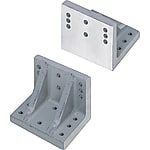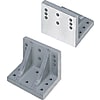(!) Since support from Microsoft will end on January 14th, 2020, Windows 7 will be excluded from the recommended environment from December 15th, 2019 on this site. Vì lý do Microsoft kết thúc hỗ trợ cho Windows 7 vào ngày 14/01/2020, Windows 7 sẽ là hệ điều hành không được khuyến khích sử dụng với trang web này từ ngày 15/12/2019.
Search by Category / Brand Tìm theo danh mục, nhãn hiệu
Search by Category Tìm theo danh mục
- Scheduled Maintenance Notice: This site will be unavailable due to scheduled maintenance from 8:00 19/1/2025 to 5:00 (ICT) 20/1/2025. We apologize for the inconvenience.
- [Thông báo] Cập nhật địa chỉ kho tập kết hàng hóa tại khu vực miền Nam của MISUMI Việt Nam. Xem chi tiết.
[Announcement] Update on warehouse address in the Southern region of MISUIMI Vietnam. See more. - [Cảnh Báo] Thủ Đoạn Lừa Đảo Từ Nhân Viên Giao Hàng – Yêu Cầu Trả Phí Ship. Xem chi tiết.
[Warning] Fraud Calling from Shipper - Asking to Pay Shipping Fee. See more.
Angle Plates(Hole Machining:With Mounting Hole and Dowel Hole)
Take advantage of the convenience of FREE SHIPPING and NO MINIMUM ORDER on angle plates. If you have any doubts or need assistance in choosing the right product, our experts are readily available to provide advice and guidance
Brand |
|
|---|---|
| CAD |
|
| Days to Ship |
|
1 itemsMặt hàng
- Sort By
-
You can add up to 6 items per a category to the compare list.

MISUMI
Angle Plates - WideWide Angle Plates are commonly used in height limited space. They offer a wide variety of sizes to choose from.[Feature]● Height H (mm.) : 100 and 150● Dimension A (mm.) : 100 and 150● Hole Machining : No Hole, With Mounting Hole and With Mounting Hole and Dowel Hole● Material : FC250● Surface Treatment :Primer Paint[Application]These Angle Plates are used to hold workpieces securely and accurately during milling, drilling, grinding, or assembly processes.
Material Hole Machining Strength Surface Treatment - With Mounting Hole and Dowel Hole Standard (Cast) Primer Paint (Gray) From: 4,264,645 VND Days to Ship: Số ngày giao hàng: 6 Day(s) or more  6 Day(s) or more
6 Day(s) or more
| BrandNhãn hiệu |
|---|
| Product SeriesDòng sản phẩm |
| CADCAD |
| From |
| Days to ShipSố ngày giao hàng |
| Material |
| Hole Machining |
| Strength |
| Surface Treatment |
You can add up to 6 items per a category to the compare list. | |
| BrandNhãn hiệu | MISUMI |
| Product SeriesDòng sản phẩm | |
| CADCAD |
|
| From | 4,264,645 VND |
| Days to ShipSố ngày giao hàng | 6 Day(s) or more |
| Material | - |
| Hole Machining | With Mounting Hole and Dowel Hole |
| Strength | Standard (Cast) |
| Surface Treatment | Primer Paint (Gray) |
Loading...Tải…
ConfigureTạo
Specification/DimensionsĐặc điểm kỹ thuật / Kích thướcĐặc điểm kỹ thuật / Kích thước
-
Material
- Aluminum
-
Hole Machining
- Through Hole
- Through Hole and Tapped Hole
- Through Hole and Dowel Hole
- No Hole
- With Mounting Hole and Dowel Hole
- Mounting Hole Selectable
- With Mounting Hole
-
Strength
- Standard (Cast)
- High Strength (Welding)
-
Surface Treatment
- Electroless Nickel Plating
- Black Oxide
- Primer Paint (Gray)
- Not Provided
Related Categories to Angle PlatesDanh mục liên quan đến Angle Plates
FAQ Angle Plates
- Question: What is an angle plate used for?
- Answer: An angle plate is a tool used in machining and metalworking to hold workpieces securely at specific angles during various operations such as drilling, milling, or grinding. It provides a stable reference surface for accurate positioning and alignment.
Examples of how an angle plate is used:
1. Holding a workpiece at a 90-degree angle to perform drilling or milling operations on its sides or edges.
2. Aligning and clamping multiple workpieces together at a specific angle to create complex assemblies or welded structures.
3. Establishing a perpendicular reference surface for checking or aligning the squareness of components.
4. Creating inclined surfaces or beveled edges by tilting the angle plate to the desired angle. in case using tilting angle Plate
5. Supporting workpieces during precision measurement or inspection to ensure accurate and consistent results.
Overall, an angle plate is a versatile tool that aids in workholding, alignment, and achieving specific angles in metalworking and machining processes. - Question: What are the types of angle plate?
- Answer: There are several types of angle plates available, each designed to suit specific applications and requirements. Here are some common types of angle plates:
1. Plain Angle Plate: This is the most basic type of angle plate, consisting of a simple flat plate with two perpendicular machined surfaces. It is used for general workholding and setup applications where a flat reference surface is needed.
2. Slotted Angle Plate: Slotted angle plates have additional slots or T-slots machined into the flat surfaces. These slots allow for the attachment of clamps, bolts, or other fixtures to secure workpieces in various positions and orientations.
3. Tilting Angle Plate: Tilting angle plates, also known as adjustable angle plates, feature an adjustable mechanism that allows the plate to be tilted or swiveled to different angles. This type is used for creating inclined surfaces, beveled edges, or specific angular setups.
4. Sine Angle Plate: Sine angle plates have accurately machined angular surfaces that allow for precise angular adjustments. They are commonly used in machining applications that require precise angles for grinding, milling, or inspection operations.
5. Universal Angle Plate: Universal angle plates combine the features of plain angle plates, slotted angle plates, and tilting angle plates. They offer versatility in terms of clamping options, adjustability, and angle-setting capabilities. This type is ideal for complex setups and multi-axis machining.
6. Magnetic Angle Plate: Magnetic angle plates have a strong magnetic base that securely holds ferrous workpieces in place. They eliminate the need for clamping or bolting, providing quick and convenient workholding solutions. - Question: What is the difference between a surface plate and an angle plate?
- Answer: A surface plate and an angle plate are both precision tools used in machining and metrology, but they serve different purposes and have distinct features. Here are the key differences between a surface plate and an angle plate:
Purpose
Surface Plate: A surface plate is primarily used as a reference surface or measuring, inspecting, and flatness checking of workpieces and tools. Angle Plate: It is primarily used for workholding and setup applications. It provides a rigid and stable platform for holding workpieces at specific angles or orientations during machining operations.
Design
Surface Plate: Surface plates are large, flat, and typically rectangular or square in shape. They are made from high-quality materials like granite or cast iron.
Angle Plate: Angle plates are flat plates with two perpendicular machined surfaces, creating a 90-degree angle. They are typically made from materials like cast iron or steel.
Usage
Surface Plate: Operators use surface plates in conjunction with precision measuring tools like height gauges, dial indicators, and surface gauges.
Angle Plate: Angle plates are commonly used in conjunction with other workholding devices like vises, clamps, or fixtures to hold workpieces securely and accurately during milling, drilling, grinding, or assembly processes. - Question: What are the advantages of angle plate?
- Answer: 1. Accuracy: Angle plates provide a stable and accurate reference surface for machining operations.
2. Strength: Angle plates are made of strong materials, such as cast iron or steel. This makes them able to withstand the forces applied during machining or assembly operations.
3. Versatility: Angle plates are available in a variety of sizes and shapes, to accommodate different workpieces and applications.
4. Reusability: Angle plates are typically reusable, which can save time and money.
5. Cost-effectiveness: Angle plates are relatively inexpensive, making them a cost-effective way to improve the accuracy and precision of metalworking operations.






How can we improve?
How can we improve?
While we are not able to respond directly to comments submitted in this form, the information will be reviewed for future improvement.
Customer Privacy Policy
Thank you for your cooperation.
While we are not able to respond directly to comments submitted in this form, the information will be reviewed for future improvement.
Please use the inquiry form.
Customer Privacy Policy